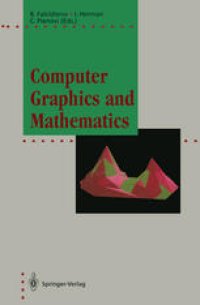
Ebook: Computer Graphics and Mathematics
- Tags: Computer Graphics, Numerical Analysis, Combinatorics, Simulation and Modeling, Algebraic Geometry, Algebraic Topology
- Series: Focus on Computer Graphics
- Year: 1992
- Publisher: Springer-Verlag Berlin Heidelberg
- Edition: 1
- Language: English
- pdf
Since its very existence as a separate field within computer science, computer graphics had to make extensive use of non-trivial mathematics, for example, projective geometry, solid modelling, and approximation theory. This interplay of mathematics and computer science is exciting, but also makes it difficult for students and researchers to assimilate or maintain a view of the necessary mathematics. The possibilities offered by an interdisciplinary approach are still not fully utilized. This book gives a selection of contributions to a workshop held near Genoa, Italy, in October 1991, where a group of mathematicians and computer scientists gathered to explore ways of extending the cooperation between mathematics and computer graphics.
Since its very existence as a separate field within computer science, computer graphics had to make extensive use of non-trivial mathematics, for example, projective geometry, solid modelling, and approximation theory. This interplay of mathematics and computer science is exciting, but also makes it difficult for students and researchers to assimilate or maintain a view of the necessary mathematics. The possibilities offered by an interdisciplinary approach are still not fully utilized. This book gives a selection of contributions to a workshop held near Genoa, Italy, in October 1991, where a group of mathematicians and computer scientists gathered to explore ways of extending the cooperation between mathematics and computer graphics.
Since its very existence as a separate field within computer science, computer graphics had to make extensive use of non-trivial mathematics, for example, projective geometry, solid modelling, and approximation theory. This interplay of mathematics and computer science is exciting, but also makes it difficult for students and researchers to assimilate or maintain a view of the necessary mathematics. The possibilities offered by an interdisciplinary approach are still not fully utilized. This book gives a selection of contributions to a workshop held near Genoa, Italy, in October 1991, where a group of mathematicians and computer scientists gathered to explore ways of extending the cooperation between mathematics and computer graphics.
Content:
Front Matter....Pages I-2
Integer Approximation to the Intersection of Three Planes with Planar Constraints....Pages 3-22
Approximate C1—blending with Triangular Cubic Patches....Pages 23-30
A Geometric Approach to B?zier Curves....Pages 31-43
Representing and Modeling of Cyclide Patches using NURBS....Pages 45-59
Local Parametrization of Space Curves at Singular Points....Pages 61-90
Shape of Curves and Surfaces: the Combinatorics....Pages 91-100
Two Surfaces Suffice....Pages 101-120
Does a Trigonometric Curve Cross an Algebraic Surface?....Pages 121-128
Incidence Relationships: Kernel Concept in Combinatorical Topology....Pages 129-146
A Taxonomy on Geometric and Topological Models....Pages 147-171
Multilevel Generation of Fractal Images Using the Associated Markov Process....Pages 173-188
Statistical Colour Quantization for Minimum Distortion....Pages 189-202
Minimizing the Absolute Value Energy Function: An Application to Geometrical Constraint-Solving....Pages 203-210
Geometric Constraint Propagation with Quantum Labels....Pages 211-228
Computer Vision, Descriptive Geometry, and Classical Mechanics....Pages 229-243
Discrete Surface Models: Constraint-based Generation and Understanding....Pages 245-261
Visualization of Depth Maps....Pages 263-284
An Analysis of Digitalization Algorithms for Non-linear Curves....Pages 285-297
Visualizing Hyperbolic Space....Pages 299-311
Back Matter....Pages 313-318
Since its very existence as a separate field within computer science, computer graphics had to make extensive use of non-trivial mathematics, for example, projective geometry, solid modelling, and approximation theory. This interplay of mathematics and computer science is exciting, but also makes it difficult for students and researchers to assimilate or maintain a view of the necessary mathematics. The possibilities offered by an interdisciplinary approach are still not fully utilized. This book gives a selection of contributions to a workshop held near Genoa, Italy, in October 1991, where a group of mathematicians and computer scientists gathered to explore ways of extending the cooperation between mathematics and computer graphics.
Content:
Front Matter....Pages I-2
Integer Approximation to the Intersection of Three Planes with Planar Constraints....Pages 3-22
Approximate C1—blending with Triangular Cubic Patches....Pages 23-30
A Geometric Approach to B?zier Curves....Pages 31-43
Representing and Modeling of Cyclide Patches using NURBS....Pages 45-59
Local Parametrization of Space Curves at Singular Points....Pages 61-90
Shape of Curves and Surfaces: the Combinatorics....Pages 91-100
Two Surfaces Suffice....Pages 101-120
Does a Trigonometric Curve Cross an Algebraic Surface?....Pages 121-128
Incidence Relationships: Kernel Concept in Combinatorical Topology....Pages 129-146
A Taxonomy on Geometric and Topological Models....Pages 147-171
Multilevel Generation of Fractal Images Using the Associated Markov Process....Pages 173-188
Statistical Colour Quantization for Minimum Distortion....Pages 189-202
Minimizing the Absolute Value Energy Function: An Application to Geometrical Constraint-Solving....Pages 203-210
Geometric Constraint Propagation with Quantum Labels....Pages 211-228
Computer Vision, Descriptive Geometry, and Classical Mechanics....Pages 229-243
Discrete Surface Models: Constraint-based Generation and Understanding....Pages 245-261
Visualization of Depth Maps....Pages 263-284
An Analysis of Digitalization Algorithms for Non-linear Curves....Pages 285-297
Visualizing Hyperbolic Space....Pages 299-311
Back Matter....Pages 313-318
....
Download the book Computer Graphics and Mathematics for free or read online
Continue reading on any device:

Last viewed books
Related books
{related-news}
Comments (0)